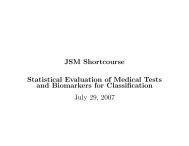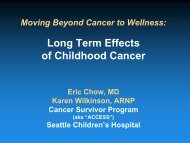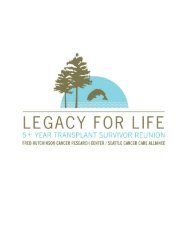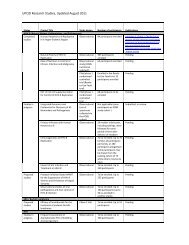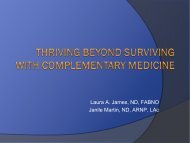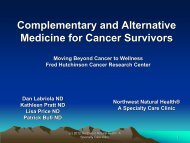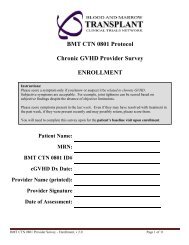Summer Undergraduate Research Program - Fred Hutchinson ...
Summer Undergraduate Research Program - Fred Hutchinson ...
Summer Undergraduate Research Program - Fred Hutchinson ...
You also want an ePaper? Increase the reach of your titles
YUMPU automatically turns print PDFs into web optimized ePapers that Google loves.
Spindle-Checkpoint targeted therapy for Glioblastoma<br />
Woong Hwang1,2 , Chris Hubert2 , Patrick Paddison2 , and James Olson2 1 University of Rochester, Rochester, NY, 2 <strong>Fred</strong> <strong>Hutchinson</strong> Cancer <strong>Research</strong> Center, Seattle, WA<br />
BrdU immunostaining<br />
3.Bromodeoxyuridine (BrdU) immunostaining<br />
Analysis of DNA replication.<br />
DNA replication after Aurora B inhibition<br />
Added BrdU at different time points for 4 hrs.<br />
60<br />
50<br />
40<br />
30<br />
20<br />
10<br />
0<br />
BrdU<br />
DAPI staining to detect total number of nuclei.<br />
%BrdU/DAPI<br />
Negative Control: No BrdU addition.<br />
Primary<br />
antibody<br />
+<br />
CB660 +DMSO<br />
CB660 +AZD<br />
333nM<br />
G166 +DMSO<br />
CB660 +AZD<br />
333nM<br />
Secondary<br />
antibody<br />
0hr 24hr 48hr 72hr 96hr<br />
Drug-treated Time<br />
ABSTRACT<br />
Glioblastoma is the most common and lethal sub-type of primary brain tumor.<br />
Median survival from the time of diagnosis is 14 months, with less than 5% of<br />
patients surviving 5 years. Hence, a new approach to the treatment of glioma needs<br />
to be developed. A recent screening collaboration between the Olson and Paddison<br />
labs has identified the spindle assembly checkpoint as a potential vulnerability in<br />
Glioblastoma. Using primary human tumor cultures, our laboratory has tested<br />
clinically relevant spindle assembly checkpoint inhibitors to determine an effect on<br />
Glioma Stem Cells(GSC) and normal Neuronal Stem Cells (NSC). Aurora Kinase<br />
B inhibitors induced more cellular multinucleation and polyploidy in GSC than in<br />
NSC. Furthermore, Aurora B inhibition uncovered the ability of GSCs to continue<br />
DNA synthesis after cell cycle arrest. Although Aurora B kinase inhibition alone<br />
does not induce apoptosis in GSCs, its ability to unmask specific DNA replication<br />
differences in GSC may make it an important tool to explore glioma biology and<br />
raise a potential role in combination therapies.<br />
2010 Best Poster Award<br />
RESULTS & DISCUSSION<br />
NSC DM SO GSC DM SO NSC AZD 0.33uM GSC AZD 0.33uM<br />
CB660(NSC)<br />
G166(GSC)<br />
Drug Serial Dilution/alamarBlue Assay<br />
48hr GNS AZD<br />
48hr NSC AZD<br />
1.2<br />
1<br />
1.2<br />
1<br />
1.2<br />
1<br />
0.8<br />
0.8<br />
0.8<br />
0.6<br />
0.6<br />
0.6<br />
BACKGROUND<br />
BrdU-GFP<br />
0.4<br />
0.4<br />
0.2<br />
0.2<br />
0.4<br />
0.2<br />
0<br />
Normalized alamarBlue<br />
alamarBlue<br />
0<br />
0<br />
0.004 0.012 0.037 0.111 0.333 1.000 3.000 9.000<br />
0.000 0.001 0.004 0.012 0.037 0.111 0.333 1.000<br />
0.001 0.004 0.012 0.037 0.111 0.333 1.000 3.000<br />
AZD dose ( uM)<br />
ZM dose (uM)<br />
ZM 437439 (uM) AZD-1152 HQPA (uM (uM) VX-680 (uM)<br />
Metaphas<br />
e<br />
Chromosome<br />
Chromosome<br />
Misalignment<br />
Misalignment<br />
No significant difference between drug treated GSC and NSC in metabolic activity.<br />
AlamarBlue data did not reflect viable cell numbers under microscope.<br />
Spindle<br />
assembl<br />
y check<br />
point<br />
Auror<br />
a B<br />
156<br />
Anaphase<br />
No<br />
Biorientation<br />
DAPI<br />
Cells treated with ZM437439, AZD-1152HQPA and VX680 shared similar morphologies<br />
suggesting drugs’ specificity to Aurora B.<br />
Drug<br />
In mitosis, the Spindle Assembly Checkpoint detects an unattached kinetochore. It delays<br />
anaphase onset until all chromosomes correctly align on the microtubule spindle apparatus.<br />
Aurora B inhibited GSCs were able to undergo DNA synthesis even after 96 hrs suggesting<br />
abnormal DNA replication programs<br />
Aurora B kinase is overexpressed in malignant glioblastoma suggesting Aurora inhibitors as<br />
potential therapeutic agents.<br />
Aurora B inhibited NSC did not significantly continue DNA synthesis after 24hrs<br />
suggesting mitotic arrest.<br />
Aurora B kinase plays an essential role in chromosome alignment, bipolar orientation and<br />
cytokinesis.<br />
CONCLUSION<br />
AZD1152-HQPA, VX680, and ZM437439 are selective Aurora B Kinase Inhibitors.<br />
1. Three different drug treated cells shared similar morphological patterns<br />
suggesting the specificity of drugs as Aurora B kinase inhibitors.<br />
DAPI in blue<br />
METHODS<br />
2. Aurora B inhibition allowed prolonged DNA replication without cytokinesis<br />
resulting in multinucleation in glioma stem cells (GSC).<br />
Neural Stem Adherent cell culture<br />
Primary human glioma stem cells and karyotypically<br />
normal neural stem cells were used.<br />
3. Aurora B inhibition allowed limited DNA replication without cytokinesis in<br />
neuronal Stem cells (NSC) .<br />
Drug treatment led to an increase in nuclear volume and cell size in four GSC lines and NSCs.<br />
All 4 glioma lines tested showed bulky abnormal nuclei whereas NSCs showed organized dual<br />
Allow for uniform exposure to growth factors, oxygen<br />
and drugs.<br />
4. The increase in polyploidy corresponded with an increase in nuclear volume and<br />
cell size in both GSCs and NSCs.<br />
nuclei.<br />
5. Aurora B inhibition alone did not induce apoptosis in GSCs<br />
Active Caspase 3/7 Assay<br />
FUTURE DIRECTION<br />
Limit differentiation effects.<br />
Reduced apoptosis.<br />
GSC cultured cells better represent patient tumors than<br />
traditional cell culture GBM lines<br />
Pollard, Cell Stem Cell 2009<br />
Apoptosis resulting Caspase from 3/7 assay Aurora B inhibition<br />
2.5<br />
1. Measure DNA content of drug treated cells by FACS sorting to quantify polyploidy.<br />
2. Confirm BrdU findings in additional normal and glioma lines.<br />
alamarBlue assay Caspase 3/7 assay<br />
2<br />
NSC 48hr<br />
GSC 48hr<br />
1.5<br />
3. Combination drug treatment that targets DNA replication.<br />
4. Investigate DNA licensing defects in GSC lines<br />
1<br />
0.5<br />
Caspase 3/7 activity (R.L.U)<br />
ACKNOLWEDGEMENT<br />
0<br />
AZD 37uM AZD111uM AZD333uM + ctrl DMSO<br />
Drug conditions<br />
This program is supported by the Continuing Umbrella of <strong>Research</strong><br />
Experience CURE) [3 P30 CA015704-36S2] and [5 P30 CA015704-35S1].<br />
Thanks for the mentorship from Chris Hubert.<br />
Positive control: Cisplatin+Etoposide+cyclosporin<br />
Caspase activity measured at different time points<br />
Aurora B inhibition alone did not induce apoptosis in GSCs<br />
(24hr, 48hr and 72hr)




